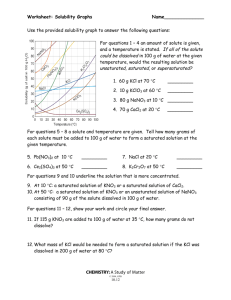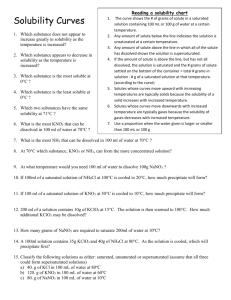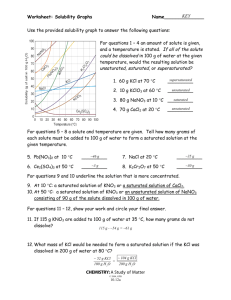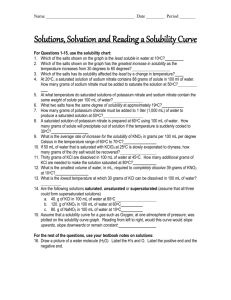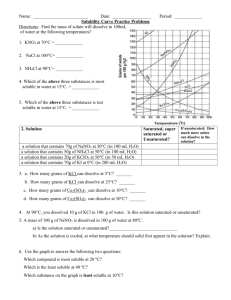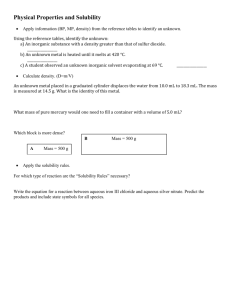WS-Solubility Chart
advertisement
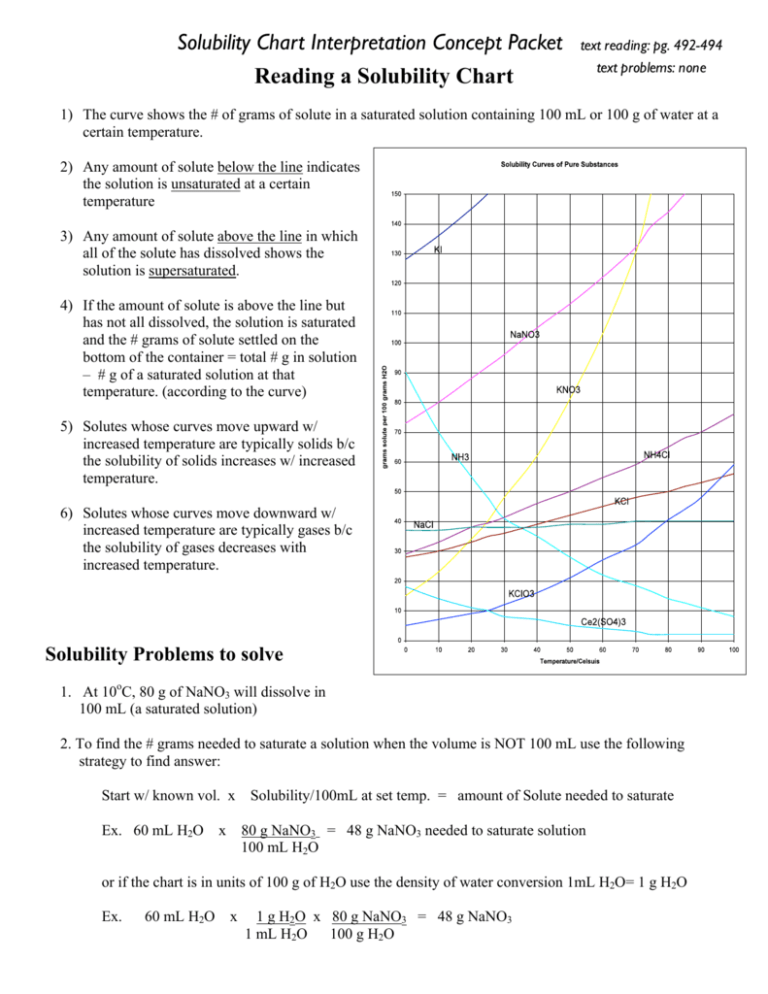
Solubility Chart Interpretation Concept Packet Reading a Solubility Chart text reading: pg. 492-494 text problems: none 1) The curve shows the # of grams of solute in a saturated solution containing 100 mL or 100 g of water at a certain temperature. 2) Any amount of solute below the line indicates the solution is unsaturated at a certain temperature 3) Any amount of solute above the line in which all of the solute has dissolved shows the solution is supersaturated. 4) If the amount of solute is above the line but has not all dissolved, the solution is saturated and the # grams of solute settled on the bottom of the container = total # g in solution – # g of a saturated solution at that temperature. (according to the curve) 5) Solutes whose curves move upward w/ increased temperature are typically solids b/c the solubility of solids increases w/ increased temperature. 6) Solutes whose curves move downward w/ increased temperature are typically gases b/c the solubility of gases decreases with increased temperature. Solubility Problems to solve 1. At 10oC, 80 g of NaNO3 will dissolve in 100 mL (a saturated solution) 2. To find the # grams needed to saturate a solution when the volume is NOT 100 mL use the following strategy to find answer: Start w/ known vol. x Ex. 60 mL H2O x Solubility/100mL at set temp. = amount of Solute needed to saturate 80 g NaNO3 = 48 g NaNO3 needed to saturate solution 100 mL H2O or if the chart is in units of 100 g of H2O use the density of water conversion 1mL H2O= 1 g H2O Ex. 60 mL H2O x 1 g H2O x 80 g NaNO3 = 48 g NaNO3 1 mL H2O 100 g H2O Worksheet: Solubility Graphs Name______________ Use the provided solubility graph to answer the following questions: For questions 1 – 4 an amount of solute is given, and a temperature is stated. If all of the solute could be dissolved in 100 g of water at the given temperature, would the resulting solution be unsaturated, saturated, or supersaturated? 1. 60 g KCl at 70 °C _________ 2. 10 g KClO3 at 60 °C _________ 3. 80 g NaNO3 at 10 °C _________ 4. 70 g CaCl2 at 20 °C _________ For questions 5 – 8 a solute and temperature are given. Tell how many grams of each solute must be added to 100 g of water to form a saturated solution at the given temperature. 5. Pb(NO3)2 at 10 °C _________ 7. NaCl at 20 °C _________ 6. Ce2(SO4)3 at 50 °C _________ 8. K2Cr2O7 at 50 °C _________ For questions 9 and 10 underline the solution that is more concentrated. 9. At 10 °C: a saturated solution of KNO3 or a saturated solution of CaCl2. 10. At 50 °C: a saturated solution of KNO3 or an unsaturated solution of NaNO3 consisting of 90 g of the solute dissolved in 100 g of water. For questions 11 – 12, show your work and circle your final answer. 11. If 115 g KNO3 are added to 100 g of water at 35 °C, how many grams do not dissolve? 12. What mass of KCl would be needed to form a saturated solution if the KCl was dissolved in 200 g of water at 80 °C? CHEMISTRY: A Study of Matter © 2004, GPB 10.12 WS - Reading the Solubility Chart Problems 1. Which of the salts shown on the graph is the least soluble in water at 10oC? 2. Which of the salts shown on the graph has the greatest increase in solubility as the temperature increases from 30 degrees to 60 degrees? 3. Which of the salts has its solubility affected the least by a change in temperature? 4. At 20oC, a saturated solution of sodium nitrate contains 100 grams of solute in 100 ml of water. How many grams of sodium chlorate must be added to saturate the solution at 50oC? 5. At what temperature do saturated solutions of potassium nitrate and sodium nitrate contain the same weight of solute per 100 mL of water? 6. What two salts have the same degree of solubility at approximately 19oC? 7. How many grams of potassium chlorate must be added to 1 liter of water to produce a saturated solution at 50oC? 8. A saturated solution of potassium nitrate is prepared at 60oC using 100.mL of water. How many grams of solute will precipitate out of solution if the temperature is suddenly cooled to 30oC? 9. What is the average rate of increase for the solubility of KNO3 in grams per 100 mL per degree Celsius in the temperature range of 60oC to 70oC? 10. If 50. mL of water that is saturated with KClO3 at 25oC is slowly evaporated to dryness, how many grams of the dry salt would be recovered? 11. Thirty grams of KCl are dissolved in 100 mL of water at 45oC. How many additional grams of KCl are needed to make the solution saturated at 80oC? 12. What is the smallest volume of water, in mL, required to completely dissolve 39 grams of KNO3 at 10oC? 13. What is the lowest temperature at which 30. grams of KCl can be dissolved in 100 mL of water? 14. Are the following solutions saturated, unsaturated or supersaturated (assume that all three could form supersaturated solutions) a. 40. g of KCl in 100 mL of water at 80oC b. 120. g of KNO3 in 100 mL of water at 60oC c. 80. g of NaNO3 in 100 mL of water at 10oC 15. Assume that a solubility curve for a gas such as ammonia, at one atmosphere of pressure, was plotted on the solubility curve graph. Reading from left to right, this curve would _____ a. slope upward b. slope downward c. go straight across
